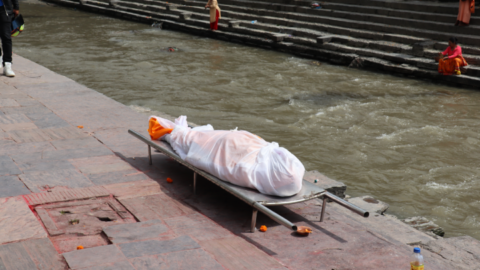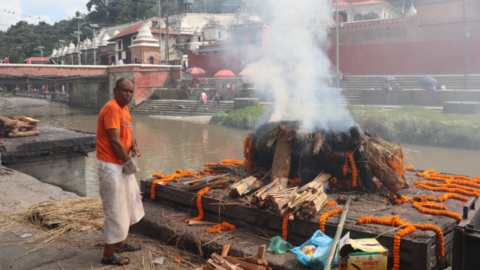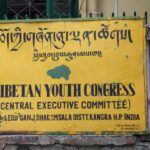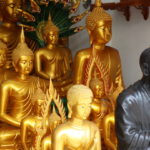At Kathmandu’s Hindu Burning Grounds, Death Is a Regular Public Matter
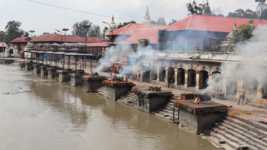
Standing amongst the burning funeral pyres at Pashupatinath on the eastern side of the city of Kathmandu, a person from Australia may be struck by the completely different approach to death Hindu people, who cremate their dead there, have.
In our country, death is often a hidden matter. Some consider it should not be spoken about, as if it somehow encourages its approach. And funerals are a distinctly serious affair. Outward expressions of grief are common and to appear anything but sombre is considered a mark of disrespect.
But, at the burning grounds in Kathmandu that line the Bagmati River, just next to the revered Pashupatinath Temple, the crowds witnessing the burning of a loved one or an associate have a much more matter-of-fact air about them.
Of course, people are grieving, and they’re saddened over their loss, but they’re also casually conversing amongst themselves.
Indeed, in the west, death is often considered the dreaded end, while in the east, it’s cycle of life.
Although just like many other aspects of daily life around the globe, the environmental impact of the traditional cremation process has been coming under scrutiny, and moderate changes have thus far been made to curb the resulting air and water population, as well as deforestation.
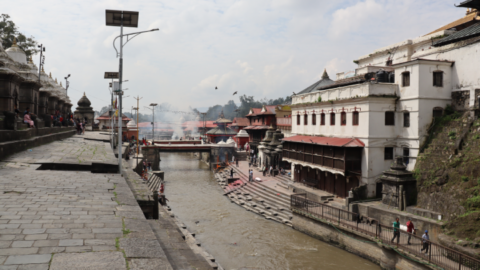
Ashes to ashes
“This is one of the places where we do the cremations,” said Deepak Thapo, as several bodies were being burnt along the riverside. “We don’t have any special times for cremation. We can do it 24/7. As soon as people die, they’re brought here to be cremated.”
“This has been happening here for thousands of years,” the guide of over two decades told Sydney Criminal Lawyers. “Cremating at this place is the culture of the Hindus.”
Thapo explains that around 50 bodies are burnt at the site every day. This can cost around 10,000 rupees, or about $120 AUD.
The majority of the wood used to form the pyre is teak, but there’s also an amount of sandalwood for purification, which depends on how much a family can afford.
A bridge over the Bagmati divides the cremation grounds. To one side is where family members carry the body down to the river to wash it before burning. And to the other is a line of about a dozen raised concrete platforms upon which the funeral pyres are built.
The reason bodies have been burnt along this section of the sacred river for centuries is that the Pashupatinath Temple, one of the Hindu religion’s most holy sites, is located to the side. And such a hallowed structure is it, that non-Hindus are refused entry.
“Hindu people like to come and visit once in a life. This temple is presented like a Mecca for the Hindu people,” Thapo advises. “Like the Christians go to Vatican City, the Jewish people go to Jerusalem and the Muslims go to Mecca, Hindus from around the world come to visit.”
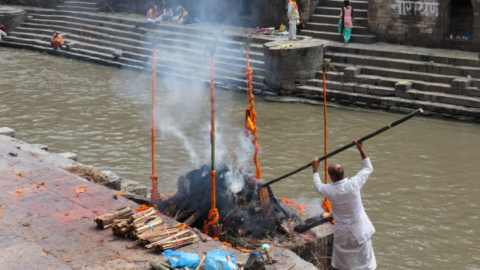
A cleansing ritual
According to Thapo, the reason that Hindus cremate their dead out in the open and next to a river is that our bodies are made from the five elements – “earth, water, fire, air and space” – so when a person dies these elements must be given back.
“Another reason, Hindu people say, is that when we die, our bodies are unclean,” the guide explained. “If we kill an animal, we can eat the meat. But if the animal dies naturally, we never eat the meat of that animal, because it’s unclean.”
“We Hindu people say that when we die our bodies are unclean, so we need to clean them by using the five elements, by going back to the fire.” he continued. “So, that’s why the Hindu people are cremated.”
This cleansing process commences prior to burning. At Pashupatinath, the deceased is carried down a set of stairs on a bamboo stretcher to a rock platform beside the river, where clothes are removed, and the body is bathed. It’s then shrouded in a cloth of white: a colour of purity.
The body is then carried by male members of the family over to the pyre. It’s walked around the stack of teak three times and placed upon it. The deceased is then covered in straw to conceal them, and the fire is lit, starting at the mouth, by a close relative.
Deepak explains that the fire takes about three hours to become a pile of ash. If you ever watch a funeral pyre burn, it takes about an hour and a half for most of the body to have disappeared. And it’s lit at the head because, as it’s the centre of the senses, it serves to purify the human past.
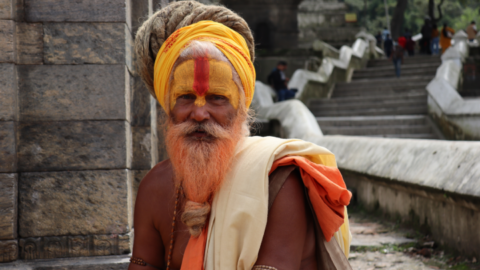
Moving with the times
Since January 2016, an electronic crematorium has also been operating at Pashupatinath. The result of a 34 year campaign by the Pashupati Area Development Trust, its aim is to reduce the negative environmental impact that the traditional cremation process is having on the local environment.
At the time the facility was opened, PADT secretary Dr Govinda Tandon outlined, “It will take some time for people to accept the new method, but we hope they will soon realise that it is cheaper and environmentally-friendly.”
As Pashupatinath is a World Heritage Site, UNESCO had shown some opposition to the implementation of a modern form of cremation, which only costs around Rs 3,000, or $35 AUD, and takes about 45 minutes to incinerate a dead person.
Thapo advises that the electronic crematorium, which was funded by the government at a cost of Rs 110,000, is mainly where the authorities are cremating homeless people at present.
Renouncing worldly life
Two types of people are buried in the Hindu tradition, as they’re considered clean at the time of death. These are children and sadhus, who are holy people that renounce living amongst regular human society to walk the earth living a life of asceticism.
Sadhus are easily recognised, as they’re often dressed in orange robes and sport long dreadlocks, similar to the fashion of the god Shiva, lord of destruction, whom they worship. Pashupatinath is actually named after Shiva in his form of Pashupati, lord of the animals.
As he stands beside the Bagmati River, Thapo explains that sadhus renounce worldly life because it “takes 8.4 million rebirths” through all the different types of sentient beings to reach the human form, and that’s the only one in which “moksha”, or freedom from the cycle of life, can be achieved.
“So, they think it’s worthwhile to take this opportunity,” he adds.
